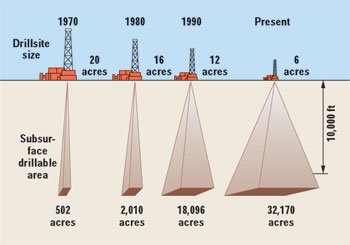Editorial Comment
Vol. 224 No. 4 THOMAS R. WRIGHT, JR., PUBLISHER Some enviro-facts to remember. Our industry will likely never completely overcome the average citizen’s perception that we are polluters and defilers of the environment. However, following are a
Some enviro-facts to remember. Our industry will likely never completely overcome the average citizen’s perception that we are polluters and defilers of the environment. However, following are a few facts and observations that should be made known to our detractors: • Over the last 30 years, the surface area required for the average working drilling rig has been reduced by 70%, from 20 acres to only six acres. At the same time, the areal extent of a reservoir that such a rig can develop at 10,000 ft has increased 63-fold, from 502 acres in 1970 to around 32,000 acres today (see accompanying illustration). William Lawson, director of the National Petroleum Technology Office of the US Department of Energy, said industry is shrinking the rig footprint needed for field development by “drilling a lot of wells from one pad . . . doing lateral wells.” As a result (we) “are saving a lot of money and really reducing the impact on the environment.” • Nearly half the land on Earth remains wilderness – undeveloped and nearly unpopulated. Despite the fact that this was reported in a study by 200 international scientists of the greenie persuasion, it could be useful ammunition in the argument for opening more areas to oil and gas development. “A lot of the planet is still in pretty decent shape,” said Russell Mittermeier, a Harvard primatologist (whatever that is) and president of Conservation International, Washington, D.C., which organized the study. Using databases, computer maps and satellite photos, the study found that 46% of the Earth’s land can be classified as wilderness – from the forests of Russia, Canada and Alaska to the Congo, the Amazon, the Sahara and New Guinea. Totaling 68 million sq km, this wilderness is seven times the size of the US and home to only 2.4% of world population. Antarctica and the Arctic tundra make up roughly a third of this wilderness, or 23 million sq km. Thus, it seems entirely logical to us that industry could have access to a few hundred km of this frozen wasteland (oops, wilderness). The research was conducted by scientists from such institutions as the World Bank, Cambridge and Harvard Universities, Zimbabwe’s Biodiversity Foundation for Africa and the National Amazon Research Institute in Brazil. Results will be published next year by the University of Chicago Press in a 500-page book titled Wilderness: Earth’s Last Wild Places. The study was funded in part by donations from Intel co-founder Gordon Moore, a major donor to Conservation International. • Worldwide, the majority of petroleum pollution in the oceans comes from marine transportation (about 45%) and municipal/industrial waste and street runoff (nearly 36%).
Conversely, during the past 20 years only 3% of the oil spilled on the US OCS came from offshore production facilities and pipelines. According to the US Minerals Management Service, some 1,700 bbl of oil per day get into the oceans from natural seeps. This is 150 times more than the oil (reported?) spilled from OCS oil and gas activities. From junk science to junk law. The Attorneys General (AGs) of Massachusetts, Connecticut and Maine filed a notice of intent to sue US Environmental Protection Agency (EPA) Administrator Christine Todd Whitman unless she agrees to propose mandatory controls on emissions of carbon dioxide. The AGs assert that it is Whitman’s duty, under Section 108 of the Clean Air Act (CAA), to begin the process of regulating CO2. But according to the Competitive Enterprise Institute (CEI), “it is not difficult to see what the AGs stand to gain if EPA classifies CO2 as a regulated pollutant. Instantly, tens of thousands of law-abiding and environmentally responsible businesses (e.g., all fossil fuel users) would become polluters.” The number of firms potentially in violation of the CAA would increase exponentially. Since states have primary responsibility for enforcing CAA, the AGs’ prosecutorial domain would grow by orders of magnitude. CEI argues that it is inconceivable (on an issue of longstanding debate like global warming) Congress would authorize EPA to control CO2 – potentially the most expensive regulatory project in history – without ever once saying so in the text of the statute. The CAA’s sole mention of CO2 occurs in Section 103(g), which directs the administrator to develop non-regulatory strategies. The CAA’s sole mention of global warming occurs in Section 602(e), which directs the administrator to publish (i.e., study) the global warming potential of ozone-depleting substances. In short, CAA mentions CO2 and global warming only in the context of non-regulatory provisions. CEI asserts that the AGs want to put Whitman in a cross-fire between President Bush, who opposes CO2 regulation, and the EPA career bureaucracy, which has long sought the power to regulate CO2 to increase its control over the US economy. Whitman must decide where her loyalties lie – with the rule of law, economic growth and affordable energy, or with the rule of bureaucrats, regulatory excess and Kyoto-style energy rationing. The AGs’ action gives Whitman a superb opportunity to repudiate Clinton-Gore’s mischievous legal opinions and avert an era of anti-energy litigation.
|
|||||||||
- Prices and governmental policies combine to stymie Canadian upstream growth (February 2024)
- U.S. producing gas wells increase despite low prices (February 2024)
- U.S. drilling: More of the same expected (February 2024)
- U.S. oil and natural gas production hits record highs (February 2024)
- U.S. upstream muddles along, with an eye toward 2024 (September 2023)
- Canada's upstream soldiers on despite governmental interference (September 2023)





